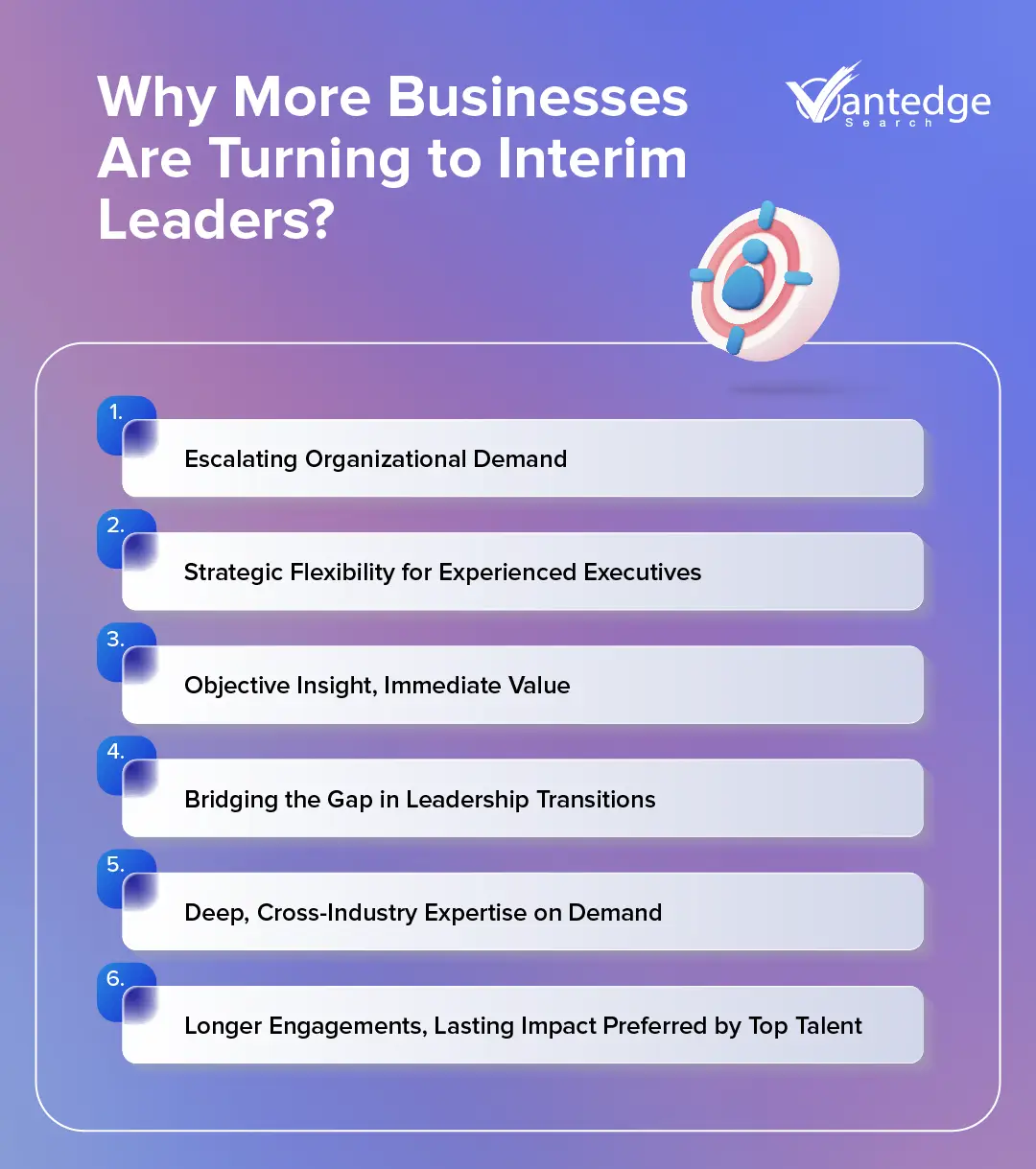
Maximizing Corporate Success: The Strategic Advantages of Interim Executive Leadership in the C-suite
Table of Content
In today’s business landscape, the strategic deployment of leadership resources can be the difference between thriving and merely surviving. Enter the realm of interim executive leadership—a transformative approach that has become increasingly vital in the C-suite of modern organizations. The concept revolves around engaging seasoned executives on a temporary basis, often during periods of transition, significant change, or crisis management. Unlike traditional leadership roles, interim executives bring a unique blend of flexibility and expertise, tailored to navigate companies through turbulent times, alongside charting a course towards new horizons of success and innovation.
The rise of interim executive services and solutions marks a significant shift in how businesses approach leadership challenges. In an era where agility and adaptability are key, the benefits of interim leadership are manifold. They offer the critical expertise and experience necessary for guiding companies through uncharted waters, which could be driving a merger, overseeing a major project, or filling a sudden gap in the company’s leadership. Interim executives, especially, have emerged as a cost-effective solution for businesses seeking C-suite expertise without the long-term commitment or expense of a full-time executive. It is mainly beneficial for small to medium-sized businesses or specific sectors within larger corporations that require focused, strategic leadership.
Navigating change with precision: The emergence of interim executive services and leadership
The rise of interim leadership can be attributed to several factors, including the need for organizations to navigate transitional periods, address leadership gaps, and drive transformation. Some key aspects of the rise of interim leadership are:
- Escalating demand: Organizations, particularly those with private equity backing or international headquarters, are increasingly turning to interim executives to address complex challenges and lead organizations through periods of change. The demand is reflective of the growing recognition of the strategic value interim leaders bring during crucial organizational shifts.
- Flexibility and adaptability: Interim leaders balance professional ambition with personal flexibility. Adaptability makes them an attractive option for experienced executives looking for a unique career opportunity. Interim involvement allows them to impart substantial impact without the commitment of a full-time position.
- Fresh perspectives through interim executive services: Interim leaders offer unbiased insights and help organizations realign their strategies, maintaining resilience during challenging times. The fresh perspectives brought by these leaders are a cornerstone of interim executive services, fostering innovation and strategic realignment.
- Time for recruitment and interim recruiting: Interim leadership allows organizations to take their time in identifying and appointing a permanent successor. Interim recruiting processes pave the way for a smooth transition and minimize disruptions to the business.
- Knowledge and experience from interim executive solutions: Bringing valuable insights from various industries and leadership roles, interim leaders are invaluable assets for organizations looking to address complex challenges. Their diverse experience is a key component, ensuring deep knowledge and expertise.
- Extending engagements and high conversion rates: Initial interim executive engagements typically start with a 3-to-4-month commitment, but there is a trend of extending these engagements, often running for a year. The high conversion rate of interim executives to full-time positions highlights their effectiveness and the deep impact they can have on an organization.
- Growing popularity of interim roles: Interim leadership roles are becoming more popular as they provide unique opportunities for growth, diversity, and impact that are hard to find in traditional roles. As the landscape of business leadership continues to evolve, the appeal of interim leadership is increasingly recognized by many senior executives.

Exploring the advantages of interim executives
- Rapid Expertise : Interim executives, a key facet of interim executive services, offer immediate, high-level expertise in times of organizational need. Their deep experience in various leadership roles enables them to quickly discern and align with an organization’s goals and objectives. These leaders, adept in managing transitional periods and crises, bring specialized skills crucial for addressing unique challenges. Their role in providing targeted, industry-specific solutions underscores the growing importance of interim leadership in today’s business landscape. Rapid deployment of experienced leadership is essential for maintaining operational continuity and achieving strategic milestones in a fluid corporate environment. By filling leadership gaps promptly, interim executives help mitigate risks associated with periods of transition or leadership voids.
- Objective Decision-making : Interim executive leadership is associated with objective decision-making at organizations, as it is untainted by internal biases or long-term dynamics. Interim leaders provide clear, unbiased insights and solutions, especially crucial during transitional periods or crises. An impartial and strategic perspective ensures decisions are strategically aligned with the organization’s immediate needs, and business strategies with market demands and organizational goals.
- Cost-effectiveness: Engaging interim executives is a cost-effective solution for organizations, particularly beneficial for short-term projects or transitional periods. Interim executive services eliminate the need for the long-term financial commitments associated with a permanent executive hire. Additionally, as these leaders often function in an interim executive capacity, they typically do not require benefits, dedicated office space, or extensive equipment. Therefore, interim leaders appear as a financially savvy choice for companies aiming to minimize overhead costs while leveraging the strategic advantages of experienced leadership.
- Flexibility and speed: Interim executives stand out for their fast and flexible solutions, crucial for businesses aiming to achieve short-term goals or navigate through transitions and crises. Interim executives are used to adapting to new environments quickly. This renders them effective in understanding and addressing the unique challenges of different organizations. They enable organizations to respond swiftly to market changes or internal challenges. These leaders bring specialized skills for a fraction of the time, adapting quickly to the evolving needs of the business. Speed and adaptability are particularly beneficial in dynamic business environments, allowing companies to maintain momentum and operational efficiency without the long-term commitments or constraints of traditional executive roles.
- Specialized skills: Interim executives often possess specialized skills and experience that complement the existing leadership team. The infusion of expertise is particularly valuable in filling skill gaps and offering new perspectives that might not be inherent within the organization. Their diverse background equips them with a unique set of skills and insights. Equipped with specialization across industries, they can tackle specific challenges effectively, applying industry-specific best practices and innovative strategies.
Need interim leadership ? Vantedge delivers executive impact.
6. Change management: Interim executives are typically adept at managing change, using their experience from various industries and companies to guide organizations through transformational periods. They bring a wealth of experience and expertise, providing valuable insights and guidance to organizations facing significant change and transition. These executives often possess specialized expertise in niche areas or industries, enabling them to tackle complex challenges, implement industry-specific best practices, and provide targeted solutions for specific situations. Additionally, they can help bridge the gap between outgoing and incoming leadership, ensuring a smooth transition and continuity of operations. Interim leaders can also facilitate knowledge transfer and training, supporting the organization’s development during phases of change. The valuable insights they offer make them an asset for transition and transformation.
7. Knowledge transfer: Interim executives can help in knowledge transfer by sharing their expertise and industry knowledge with the organization. They can help develop the skills and knowledge required to manage change, facilitating knowledge transfer and training. Interim executives can also evaluate the organization’s strengths and weaknesses, conduct a comprehensive review, and identify areas for improvement. They can design functional structures, develop policies and procedures, and recruit key personnel to build effective teams. Additionally, interim executives can facilitate collaboration and integration, promoting knowledge sharing, best practices, and insights to ensure a smooth transition. They can also help bridge the gap between outgoing and incoming leadership, ensuring a smooth transition and continuity of operations. Therefore, interim executives can provide valuable insights and guidance to organizations facing significant change and transition, supporting knowledge transfer and training, and facilitating a smooth transition.
8. Interim executive leadership as a test-drive for permanent roles: Engaging interim executives presents a unique opportunity for organizations to assess the suitability of potential long-term leadership. The approach entails a thorough evaluation of an executive’s fit within the company’s culture and operational dynamics, without the immediate commitment of a permanent hire. By leveraging interim executive services, companies gain valuable insights and a firsthand experience of leadership effectiveness before making a decisive move towards a permanent appointment.
9. Boosting corporate prestige with interim leadership: The engagement of high-caliber interim executives is a powerful move to enhance the reputation of a company. Bringing in interim executive leadership demonstrates a strong commitment to robust management and strategic development. It signals to stakeholders the seriousness of the organization’s leadership goals and also showcases the adaptability and forward-thinking nature of the business. Interim executive solutions, in this context, serve as a testament to the company’s dedication to excellence and its ability to attract top-tier leadership talent even in transitional phases.
10. Laying the foundation with interim recruiting – preparation for future leadership: The strategic placement of interim executives plays a crucial role in preparing the ground for future permanent leadership within an organization. The approach, often facilitated through focused interim recruiting, ensures a smoother transition and continuity in leadership roles. Companies benefit from the foresight and expertise of interim leaders who can set the stage for the next generation of permanent leadership. This process not only stabilizes the present but also meticulously architects the future, making interim executive leadership a cornerstone for enduring corporate success.
Conclusion
Interim executive leadership offers a pivotal advantage in today’s rapidly evolving business world. By embracing interim executives and leaders, organizations not only navigate through transitional periods with precision but also lay a robust foundation for future permanent leadership. The unique blend of experience, flexibility, and specialized skills that these leaders bring plays a crucial role in enhancing company reputation, driving effective change management, and ensuring continuity in leadership. Furthermore, the use of interim recruiting services allows for a seamless integration of new perspectives and innovative strategies, preparing businesses to meet the challenges of tomorrow. As we look ahead, the growing trend of leveraging interim leadership underscores its significance in shaping resilient, forward-thinking, and successful organizations.
Interested in leveraging the strategic advantages of interim executive leadership for your organization?
Contact us today to explore tailored solutions.
FAQs
It’s the short-term placement of seasoned C-suite leaders during transitions or crises to ensure stability, direction, and immediate strategic impact.
Sectors facing disruption—like tech, healthcare, private equity, and manufacturing—leverage interim leadership for fast, expert-led transformation.
Interim executives provide high-impact leadership without long-term cost burdens—no benefits, equity, or severance—making them a smart investment.
They offer rapid objectivity and results, stepping in without internal bias or long onboarding, with a focused mandate and clear exit timeline.
Yes. Many interim leaders convert to full-time roles after proving their fit and effectiveness during high-stakes engagements.

